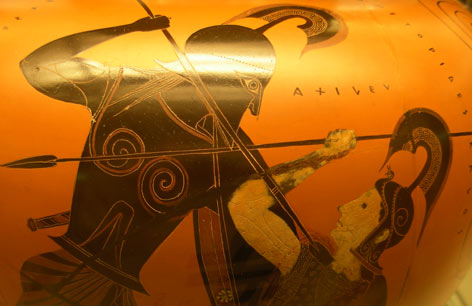
Photograph © Copyright, 2008, Bruce McMenomy.
Week 4: Homer’s Iliad, Books 1-8
(ca. 800 B.C.)
Please have read by your classtime this week:
- Introductory notes on Homer and the Greek Epic
- Homer, The Iliad, Bks. 1-8.
The whole stretch from Iliad 1-8 is about 180 pp. of reading. For some of you, that will be a relative breeze; for others it may prove quite difficult. Do not try to do it all at one go. Homer’s vocabulary and diction (even in translation) are unusual, and they take some time to soak in. If you aren’t sure you can really handle the reading, try to cover books 1, 3, 6, and 8 in particular, and fill in the rest later. If you are sure you will cover the whole thing, read them in order. They were, after all, meant to be read (or rather heard) that way.
The trick here is to give you as much exposure as I can to this extraordinary poet, without turning the whole into a course in nothing but Homer (which would be fun, but not what we advertised — and I do offer a Homer course as Greek IV anyway). The Iliad of course benefits from a complete reading, and the cumulative effect of the work is quite stunning. If you have had trouble getting the book, let me know. I prefer for you to read the Fagles translation for several reasons, but if that’s impossible, you may read it from another translation.
Consider and be ready to discuss these questions:
- What is the overall structure of the poem? By this I am not referring to its breakdown into books, which is a very late and rather arbitrary feature, but to the “arc” of the story. How is conflict created, and how is it resolved? What parts of it are internal and what parts are external? What is the relationship between the internal conflict and the external conflict?
- How does Homer position his characters in a moral sense? Does he express a partiality for one side over another? Does he tell you what kind of person someone was?
- What are Homer’s techniques for depicting a character? Which scenes leap out at you as being particularly good pieces of character description? Consider the use of epithets. These are obviously descriptive of characters, but are they meant to characterize? Which ones actually tell us something critical? What other tools are used?
- What is the role of truth and falsehood in the Iliad? What part does deception play? Is it admirable? Are those who practice it admired? Are characters dishonest with one another? If so, which ones are they?
- Do you discover extended metaphors? Where? What are they? What do they do for you?
- Look at digressions. Where do they occur? What is the point of these? Why do they occur (this topic will come up again as we approach the Odyssey with Auerbach.)
- Count the number of uses of the letter "L" in the title Iliad. Hint: you should come up with a count of one. Commit this to memory as something to steel your nerve whenever you’re inclined to insert a second one.
Further optional reading:
- Bernard Knox’s introduction to the Fagles translation is a very solid overview of some of the main interpretive points, and quite well written.
- Gregory Nagy, The Best of the Achaeans, Baltimore, 1981. One of the best expositions of the character of the hero in Greek epic by a prominent classical scholar.
Contents of this page © Copyright 2001, 2003, 2006, 2010 by Bruce A. McMenomy.
Permission to print or reproduce this page is hereby given to members of Scholars Online for purposes of personal study only. All other use constitutes a violation of copyright.